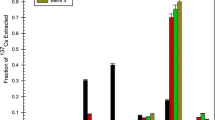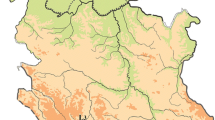Abstract
The United States conducted a series of nuclear tests from 1946 to 1958 at Bikini, a coral atoll, in the Marshall Islands (MI). The aquatic and terrestrial environments of the atoll are still contaminated with several long-lived radionuclides that were generated during testing. The four major radionuclides found in terrestrial plants and soils are cesium-137, strontium-90, plutonium-239+240 and americium-241. Cesium-137 in the coral soils is more available for uptake by plants than 137Cs associated with continental soils of North America or Europe. Soil-to-plant 137Cs median concentration ratios (CR) (kBq·kg-1 dry weight plant/kBq·kg-1 dry weight soil) for tropical fruits and vegetables range between 0.8 and 36, much larger than the range of 0.005 to 0.5 reported for vegetation in temperate zones. Conversely, 90Sr median CRs range from 0.006 to 1.0 at the atoll versus a range from 0.02 to 3.0 for continental silica-based soils. Thus, the relative uptake of 137Cs and 90Sr by plants in carbonate soils is reversed from that observed in silica-based soils. The CRs for 239+240Pu and 241Am are very similar to those observed in continental soils. Values range from 10-6 to 10-4 for both 239+240Pu and 241Am. No significant difference is observed between the two in coral soil. The uptake of 137Cs by plants is enhanced because of the absence of mineral binding sites and the low concentration of potassium in the coral soil. Cesium-137 is bound to the organic fraction of the soil, whereas 90Sr, 239+240Pu and 241Am are primarily bound to soil particles. Assessment of plant uptake for 137Cs and 90Sr into locally grown food crops was a major contributing factor in: (1) reliably predicting the radiological dose for returning residents and (2) developing a strategy to limit the availability and uptake of 137Cs into locally grown food crops.
Similar content being viewed by others
References
W. L. Robison, K. T. Bogen, C. L. Conrado, Health Phys., 73 (1997) 100.
W. L. Robison, E. L. Stone, Health Phys., 62 (1992) 496.
W. L. Robison, E. L. Stone, The Evaluation of Critical Pathways: Working Towards a Cleaner Environment, Session 17: ER Progress in Cleaning Up Nuclear Weapons Test Sites-II, Tucson, AZ, March 1–5 1998.
K. O. Emery, J. I. Tracy, H. S. Ladd, Geology of Bikini and Nearby Atolls, U.S. Geological Survey, U.S. Government Printing Office, Washington, DC, Professional Paper 260-A, 1954.
M. L. Stuart, Collection and Processing of Plant, Animal and Soil Samples from Bikini, Enewetak and Rongelap Atolls, Lawrence Livermore National Laboratory, Livermore, CA, UCRL-ID-120427, 1995.
J. L. Brunk, Gamma Analysis of Environmental Samples from the Marshall Islands, Lawrence Livermore National Laboratory, Livermore, CA, UCRL-ID-122251, 1995.
K. M. Wong, T. A. Jokela, V. E. Noshkin, Radiochemical Procedures for Analysis of Pu, Am, Ca, and Sr in Water, Soil, Sediments and Biota Samples, Lawrence Livermore National Laboratory, Livermore, CA, UCRL-ID-116497, 1994.
S. Kehl, M. E. Mount, W. L. Robison, The Northern Marshall Islands Radiological Survey: A Quality Control Program for Radiochemical and Gamma Spectroscopy Analysis, Lawrence Livermore National Laboratory, Livermore, CA, UCRL-ID-1204290, 1995.
D. A. Barber, Nature, 204 (1964) 1326.
M. T. Kaddah, Soil Sci., 105 (1968) 369.
W. Kuhn, J. Handl, P. Schuller, Health Phys., 46 (1984) 1083.
R. G. Menzel, Health Phys., 11 (1965) 1325.
L. Fredriksson, Studies on Plant Absorption of 90Sr and 137Cs from Some Tropical and Subtropical Soils, Forsvarets Forskningsanstalt, FOA Rapport A: 4319–4623, 1963.
T. J. D'Souza, E. Fagniart, R. Kirchmann, Effects of Clay Mineral Type and Organic Matter on the Uptake of Radiocesium by Pature Plants, Centre d'Etude de l'Energie Nucléaire, Mol, Belgium, Report No. BLG-538, 1980.
T. Tamura, D. Jacobs, Health Phys., 2 (1960) 391.
International Atomic Energy Agency (IAEA), Handbook of Parameter Values for the Prediction of Radionuclide Transfer in Temperate Environments, Produced in collaboration with the International Union of Radioecologists, IAEA, Vienna, Austria, Technical Report Series No. 364, 1994.
N. Green, B. T. Wilkins, D. J. Hammond, J. Radioanal. Nucl. Chem., 226 (1997) 195.
Y. C. Ng, C. S. Colsher, S. E. Thompson, Soil to Plant Concentration Factors for Radiological Assessments, Rep. NUREG/CR-2975, Lawrence Livermore National Laboratory, Livermore, CA, UCID-19463, 1982.
Author information
Authors and Affiliations
Rights and permissions
About this article
Cite this article
Robison, W.L., Conrado, C.L., Hamilton, T.F. et al. The Effect of Carbonate Soil on Transport and Dose Estimates for Long-Lived Radionuclides at a U.S. Pacific Test Site. Journal of Radioanalytical and Nuclear Chemistry 243, 459–465 (2000). https://doi.org/10.1023/A:1016090517426
Issue Date:
DOI: https://doi.org/10.1023/A:1016090517426




